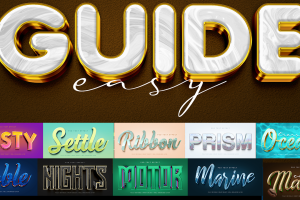
Designing eye-catching food menus and restaurant social media flyers is essential for attracting and retaining customers. With Photoshop, you can create professional and visually appealing designs that showcase your offerings effectively. In this tutorial, we’ll walk you through the process of editing food menus and social media flyers using Photoshop, ensuring your designs stand out and resonate with your audience.
Getting Started: Preparing Your Workspace
Before diving into the design process, ensure your Photoshop workspace is set up for efficiency. Open Photoshop and create a new project with the dimensions suited for your menu or flyer. Typically, menus are designed in standard print sizes (such as 8.5″ x 11″), while social media flyers can vary depending on the platform (Instagram posts are 1080 x 1080 pixels, for instance).
- Create a New Document: Go to File > New. Set the width, height, resolution (300 DPI for print, 72 DPI for digital), and color mode (CMYK for print, RGB for digital).
- Organize Your Layers: Name your layers clearly (e.g., Background, Text, Images). Group related layers to keep your workspace tidy.
Step 1: Designing the Food Menu
Choosing a Template
Start with a template to streamline the design process. Templates provide a professional layout that you can customize with your branding.
- Open Your Template: If you have a template, open it in Photoshop (File > Open). If not, you can create one from scratch or download a free template online.
- Customize the Background: Use solid colors, gradients, or images that align with your restaurant’s theme. Go to Layer > New Fill Layer to add a new background.
Adding and Styling Text
Text is a critical component of your menu. Ensure your fonts are readable and match your restaurant’s style.
- Add Text: Use the Text tool (T) to add menu items. Choose a font that is clear and complements your restaurant’s brand.
- Organize Sections: Divide your menu into logical sections (e.g., Appetizers, Main Courses, Desserts). Use larger fonts or different colors to differentiate headings from item descriptions.
- Apply Styles: Highlight special items or discounts with bold, italic, or different colored fonts. Use Layer Styles (Layer > Layer Style) to add effects like shadows or strokes to make text pop.
Incorporating Images
Images can make your menu more appealing and give customers a preview of your dishes.
- Insert Images: Go to File > Place Embedded to insert images of your dishes. Resize and position them appropriately.
- Edit Images: Use adjustment layers (Layer > New Adjustment Layer) to enhance your images’ brightness, contrast, and saturation.
- Add Image Effects: Apply filters or effects to blend images with the menu’s overall design. Use the Filter menu to explore options like blur, sharpen, or artistic effects.
Step 2: Creating Social Media Flyers
Setting Up the Canvas
Flyers should be visually striking and concise, conveying your message quickly.
- Create a New Document: For social media, set your dimensions based on the platform. For Instagram, use 1080 x 1080 pixels. For Facebook, a common size is 1200 x 630 pixels.
- Background Design: Choose a background that grabs attention but doesn’t overshadow the text and images. Use gradients, patterns, or high-quality images.
Crafting the Message
Your flyer should have a clear and compelling message.
- Add Headline: Use large, bold text for your main message (e.g., “Weekend Special”, “New Menu Items”).
- Include Details: Add secondary text for details like dates, offers, or contact information. Keep it concise and readable.
- Branding Elements: Include your restaurant’s logo, website, and social media handles. Place these elements where they are visible but not intrusive.
Using Visual Elements
Visuals are crucial for social media posts.
- Insert Images: Use high-quality images of your dishes or restaurant. Place them strategically to balance the flyer.
- Icons and Graphics: Use icons to represent items like phone numbers or social media handles. Add graphics like borders or shapes to enhance the design.
- Apply Consistent Styling: Ensure the colors, fonts, and styles match your brand. Use Photoshop’s Color Picker and Swatches panel to maintain consistency.
Step 3: Final Touches and Exporting
Reviewing Your Design
Before exporting, review your design for any errors or inconsistencies.
- Check Alignment: Use guides and grids (View > Show > Grid) to ensure elements are aligned.
- Proofread Text: Double-check for spelling or grammatical errors.
- Consistency: Ensure color schemes and fonts are consistent throughout the design.
Exporting for Print and Digital
Export your design in the appropriate format for its intended use.
- For Print: Go to File > Export > Export As. Choose PDF for high-quality prints. Ensure CMYK color mode and 300 DPI resolution.
- For Digital: Export as PNG or JPEG. Choose RGB color mode and 72 DPI resolution. Optimize file size for faster loading times on social media.
Conclusion
Creating stunning food menus and social media flyers in Photoshop is a skill that can greatly benefit your restaurant’s marketing efforts. By following these steps, you can produce professional designs that attract and engage customers. Remember to maintain consistency with your restaurant’s branding and keep your designs clear and appealing.
Feel free to download the Photoshop templates I’ve shared to get started on your own designs. Happy designing!
By applying these steps and using the templates provided, you’ll be well on your way to creating captivating food menus and social media flyers that will elevate your restaurant’s presence both online and offline.
Featured Image Credit: Graphics Wonderland (Youtube Channel)






